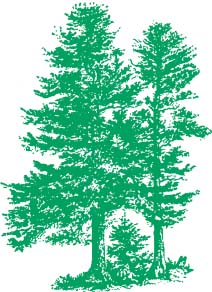The cycling of carbon in forest ecosystems is well understood (see Forest Sector Carbon Pools and Flows diagram). There is a constant flux and exchange between a forest ecosystem and the atmosphere. In temperate regions like Maine the amount of exchange and flux varies according to season.
The Earth’s atmosphere is composed of about 0.04% carbon dioxide (CO2). In order to understand the cycling of carbon in forest ecosystems, the processes of photosynthesis and respiration first need to be understood. Forest ecosystems remove CO2 from the atmosphere through the process of photosynthesis. In this process, green leaves utilize energy captured from sunlight to chemically combine water and carbon dioxide to produce sugars and oxygen. The sugars are used to produce carbon-based cellulose, the primary structural component of all plant cells. As a result, the carbon is tied up in all of a tree’s tissues – in its roots, stems, and leaves.
Carbon is given off from forest ecosystems through respiration in which oxygen and sugars are converted to carbon dioxide and water – the reverse of photosynthesis. In the process, energy is produced which is needed for a tree’s metabolic activity.
As a tree grows, it will continue to tie up more and more carbon. In fact, trees will continue to store more carbon than they give off until maturity or old age at which time a homeostasis is reached. When a tree experiences natural mortality it will start losing carbon through the process of decomposition. Microorganisms break down the dead organic matter to produce energy. In the process, some of the locked up carbon is released back into the atmosphere.
When the tree eventually falls over it still contains vast stores of carbon, which is further decomposed by soil microbes. Harvest residues and leaf fall also enter the ground decomposition phase. The litter, woody debris, and logging residue are broken down to form soil organic matter. Root systems are also broken down. Eventually the soil organic matter is completely decomposed and much of the original carbon that was fixed during photosynthesis is returned to the atmosphere.
The time between the initial trapping of the atmospheric carbon through photosynthesis and its eventual release back into the atmosphere varies depending on the longevity of the plant species concerned, the climate (principally temperature and moisture), the composition of the detritus, soil chemistry, and the degree of soil microbial activity. Carbon in temperate forests can remain stored for virtually hundreds of years in pools of live vegetation, standing dead vegetation, woody debris or soil organic matter.
In the absence of harvesting, the cycling of carbon between a forest ecosystem and the atmosphere continues, with a gradual increase in the carbon stored in the forest until an old growth stage is reached. At that point, the exchange of carbon reaches homeostasis, with as much carbon being released back to the atmosphere as is being locked up by the plants.
Harvesting results in carbon removal from a forest ecosystem. Depending on the use of the wood, the carbon removed can be held for varying lengths of time. If the wood is used for fuel, the carbon is released immediately. If it is used for paper products, the carbon generally remains fixed for a short period of time before it is released through incineration or decomposition in a landfill. However, if it is used for durable wood products such a construction materials or furniture, the carbon can remain stored for centuries.
